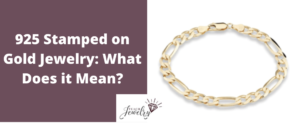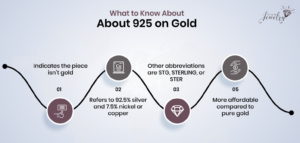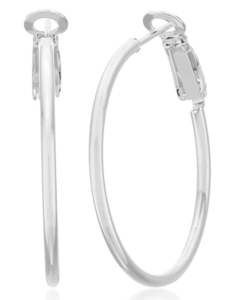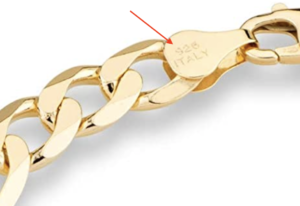
It’s important to be educated about the type of jewelry you’re planning to buy. For the average consumer, it can be difficult to know what’s real and what’s not and whether the piece is worth the price you’re paying.
One example is when you come across a piece of gold jewelry stamped with “925.”
What is 925 on Gold?
925 on gold jewelry means the piece isn’t actually gold. It’s instead a silver alloy containing 92.5 percent silver and 7.5 percent of another metal such as nickel or copper. The stamp is referred to as a “hallmark” and is placed on the jewelry so the consumer knows what type of metal they’re actually buying.

In the case of 925 stamped on gold, it means the piece is sterling silver that’s been plated with gold. It’s likely gold vermeil, which isn’t solid gold but is instead another type of metal plated with it.
It’s a common misconception 925 on gold indicates it is 92.5 percent gold. Gold is actually graded by its karatage, which most consumers recognize as 24K, 22K, 18K, and so on.
The karatage refers to the amount of gold purity in the jewelry:
- 24K = 999 / 99.9%
- 22K = 917 / 91.7%
- 20K = 833 / 83.3%
- 18K = 750 / 75%
- 14K = 583 / 58.3%
- 10K = 417 / 41.7%
That means 925 would correspond to 16.65K gold. Because that’s not a popular value for gold, it would be closest to 22K, which is about 91.7 percent.
If you’re unsure of whether a piece of jewelry is gold or just gold plated, get it evaluated by a professional jeweler. A common way to determine whether a piece is plated with gold is called an acid test, where the jeweler applies acid to the metal to distinguish it from other base metals.
What is Sterling Silver?
Sterling silver is often discussed in comparison to “pure silver.” Pure silver is often stamped 999, meaning it’s 99.9% silver. Sterling silver is a metal alloy, so it’s a combination of metals. In the case of sterling silver, that combination is generally silver plus nickel, copper, or zinc.

It’s used to make jewelry, silverware, plates, and other silver-plated items. It tarnishes quicker than pure silver because its other metals are more easily damaged.
Those downsides do come with some upsides — namely the cost. Because it has a smaller percentage of real silver, it costs less. And even though it may tarnish easier, those additional metals actually make it more durable.
925 Variations
925 isn’t the only hallmark you’ll see stamped gold jewelry to indicate it’s sterling silver. Other variations include STG, STERLING, or STER. These all mean the same thing — the jewelry isn’t actually gold but is instead sterling silver.
Additionally, you may see it stamped with “925 Italy.” In this case, the piece has been plated with gold and manufactured in Italy.

Other Stamps on Gold Jewelry
925 or another sterling silver variation isn’t the only hallmark you’ll see on gold. In some cases, you’ll see:
- GP (gold-plated)
- GEP (gold electroplated)
- RPG (rolled gold plate)
- HGE (heavy/high grade electroplate)
- HGP (heavy gold plate)
These each indicate a different method of plating the jewelry with gold, even though the underlying metal isn’t gold.
Should You Buy 925 Gold?
925 gold is an attractive option for those interested in the benefits of a gold-plated look without paying the more expensive price. To most, it’s indistinguishable from real gold, and it allows you to match it with outfits not suited for a traditional silver look.
The key is to know what you’re buying, so if you want a true piece of gold jewelry, avoid the 925 hallmark. When you buy a piece with 925, you’re actually buying mostly silver with a gold plate.

Jacob Clarke
Jacob Clarke is the founder of TeachJewelry.com.
He earned an Applied Jewelry Professional Diploma from the Gemological Institute of America (GIA) and now brings you essential information about diamonds, settings, and more.
Jacob has consulted with leading jewelry brands, and his work has been cited in Clean Origin, Diamond Nexus and industry publications.
He's also a member of the International Gem Society.
He enjoys discussing jewelry with readers, so contact him with any questions at jacob.clarke@teachjewelry.com.













